1. 선택 정렬
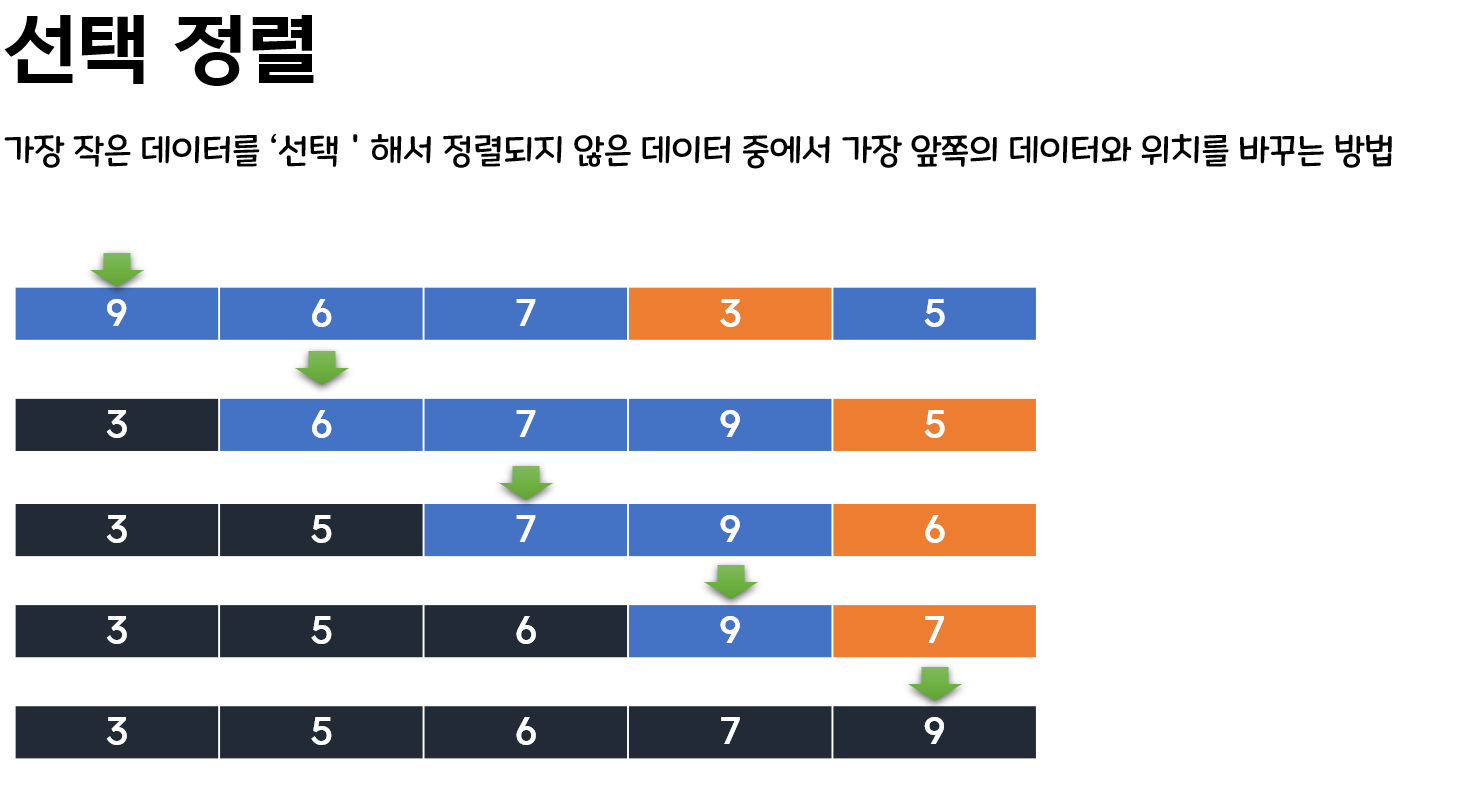
자바 코드
void selectionSort(int[] arr) {
int indexMin, temp;
for (int i = 0; i < arr.length-1; i++) { // 바꾸려고 하는 위치 선정
indexMin = i;
for (int j = i + 1; j < arr.length; j++) { // 배열을 순회하며 기준위치 보다 낮은 원소를 탐색
if (arr[j] < arr[indexMin]) { // 최저값이 나올때마다 갱신
indexMin = j;
}
}
temp = arr[indexMin]; // 값을 바꿔줌
arr[indexMin] = arr[i];
arr[i] = temp;
}
System.out.println(Arrays.toString(arr));
}시간 복잡도
N개의 데이터를 정렬한다고 했을 때
- 첫 번째 루프 : N-1 번 비교 ( index 1 ~ index N-1 )
- 두 번째 루프 : N-2 번 비교 ( index 2 ~ index N-1 )
. . . - (n-1) + (n-2) + . . . + 2 + 1 =
n(n-1)/2선택 정렬의 시간 복잡도는 이다 .
공간 복잡도
주어진 배열 내에서만 정렬이 이루어 지기 때문에 이다.
선택 정렬의 공간 복잡도는 이다.
2. 삽입 정렬
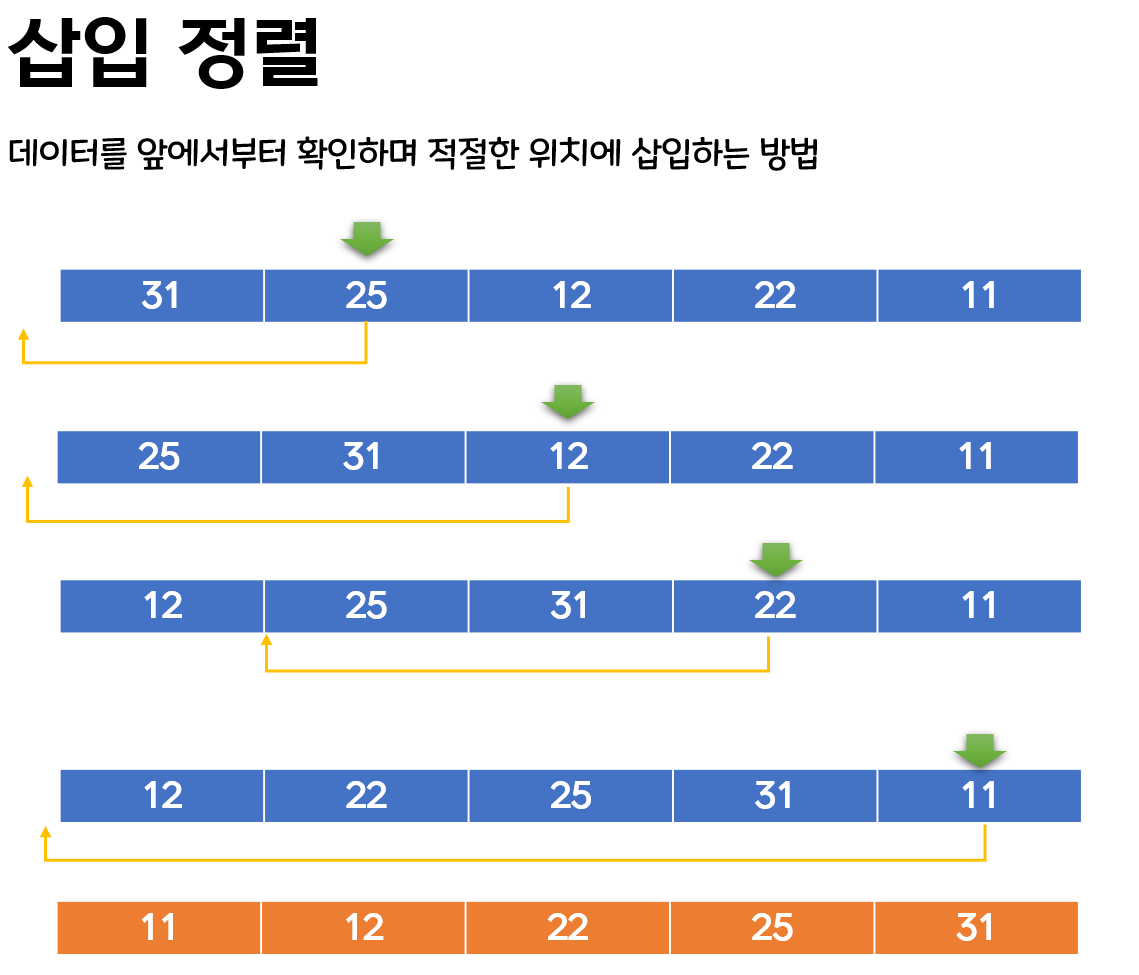
자바 코드
void insertionSort(int[] arr)
{
for(int index = 1 ; index < arr.length ; index++){
int temp = arr[index];
int aux = index - 1;
while( (aux >= 0) && ( arr[aux] > temp ) ) {
arr[aux+1] = arr[aux];
aux--;
}
arr[aux + 1] = temp;
}
}시간 복잡도
N개의 데이터를 정렬한다고 했을 때
삽입 정렬의 시간 복잡도는 이다 .
공간 복잡도
주어진 배열 내에서만 정렬이 이루어 지기 때문에 O(1) 이다.
삽입 정렬의 공간 복잡도는 이다.
3. 퀵 정렬
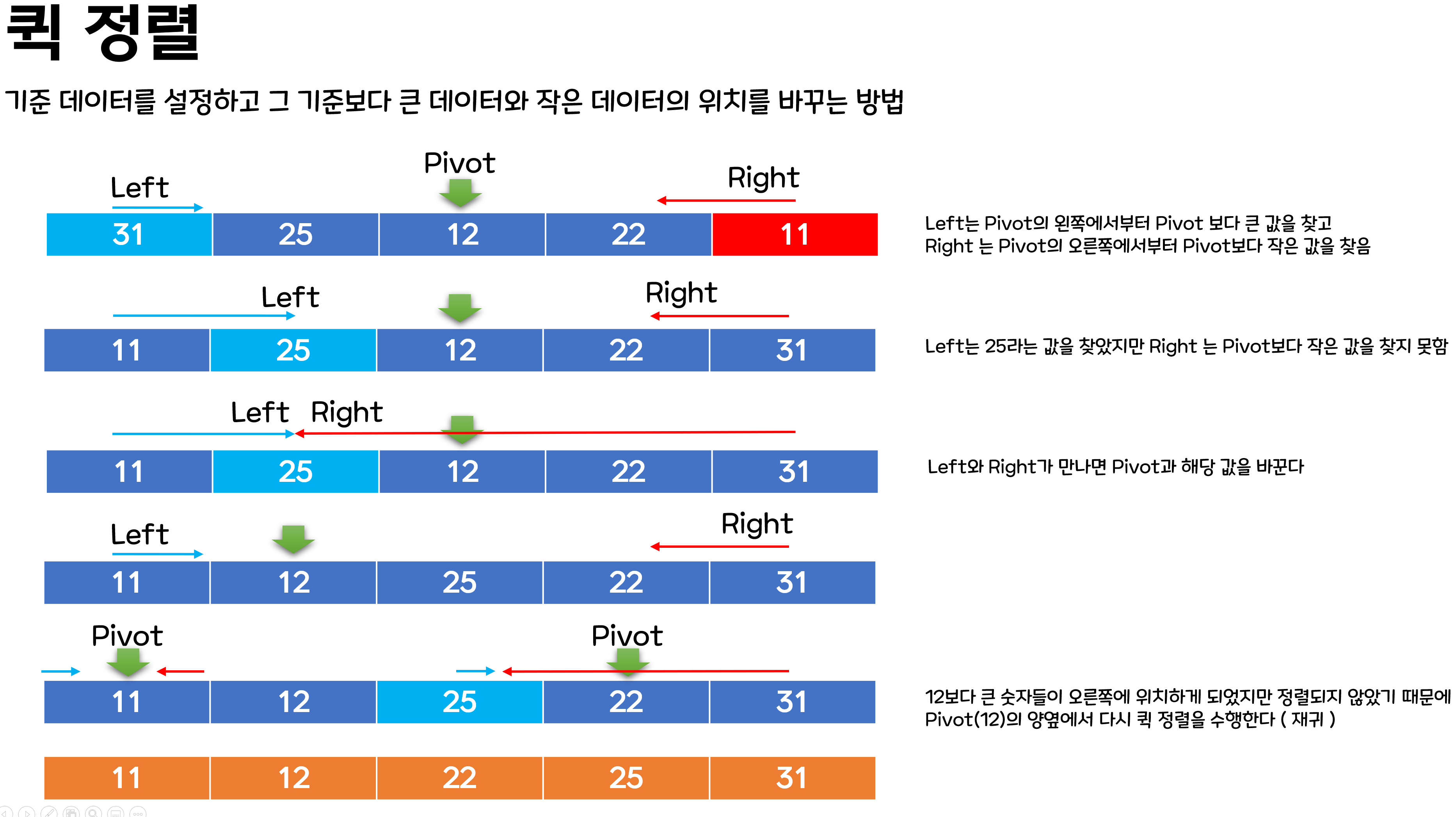
자바 코드
public void quickSort(int[] arr, int left, int right) {
int i, j, pivot, tmp;
if (left < right) {
i = left; j = right;
pivot = arr[(left+right)/2];
//분할 과정
while (i < j) {
while (arr[j] > pivot) j--;
// 이 부분에서 arr[j-1]에 접근해서 익셉션 발생가능함.
while (i < j && arr[i] < pivot) i++;
tmp = arr[i];
arr[i] = arr[j];
arr[j] = tmp;
}
//정렬 과정
quickSort(arr, left, i - 1);
quickSort(arr, i + 1, right);
}
}시간 복잡도
공부한 결과 퀵 정렬은 논리는 똑같지만 사람들 마다 구현하는 방법의 차이가 있었다. 그중 Pivot을 다양한 방법으로 설정하는 사람들이 있었는데 Pivot을 가장 처음으로 잡게 될 경우 worst case(이미 정렬되어있는 경우) 에서 성능이 저하된다. Pivot을 가운데 인덱스로 설정함으로써 최악의 경우를 피할 수 있다.
삽입 정렬의 시간 복잡도는 이다 .
공간 복잡도
주어진 배열 내에서만 정렬이 이루어 지기 때문에 O(1) 이다.
삽입 정렬의 공간 복잡도는 이다.
4. 계수 정렬

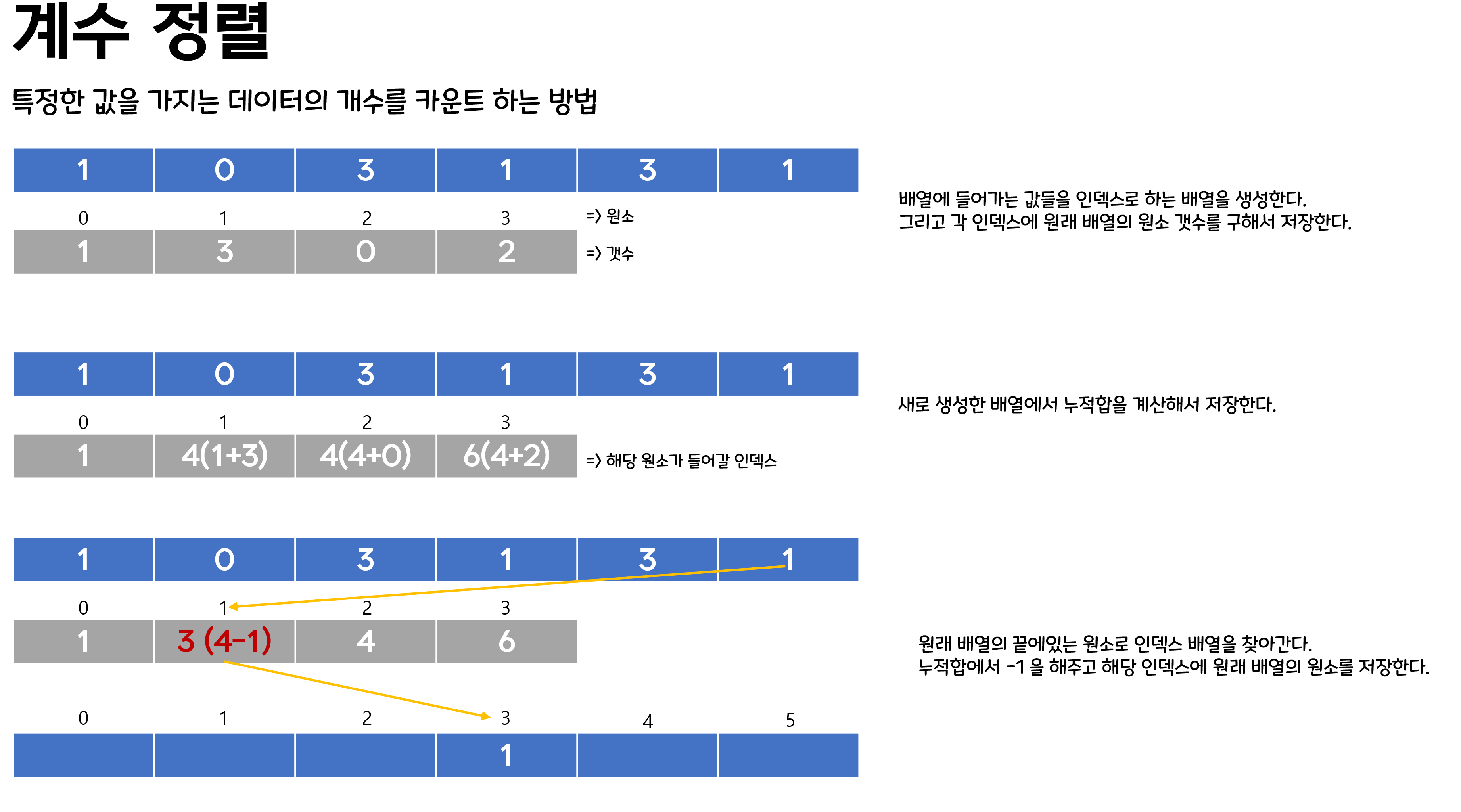





자바 코드
package Algorithm;
import java.util.Arrays;
import java.util.Random;
public class CountingSort {
static final int N = 10;
public static void main(String[] args) {
Random random = new Random(); // 랜덤함수를 이용
int[] arr = new int[N];
for (int i = 0; i < N; i++) {
arr[i] = random.nextInt(100); // 0 ~ 99
}
System.out.println("정렬 전: " + Arrays.toString(arr));
countingSort(arr);
System.out.println("정렬 후: " + Arrays.toString(arr));
}
private static void countingSort(int[] arr) {
// 최대값 구하기
int max = arr[0];
for (int i = 1; i < arr.length; i++) {
if (max < arr[i])
max = arr[i];
}
int[] counting = new int[max + 1]; // 카운팅 배열
for (int i = 0; i < N; i++) {
counting[arr[i]]++;
}
int index = 0;
for (int i = 0; i < counting.length; i++) {
while (counting[i]-- > 0) {
arr[index++] = i;
}
}
}
}시간 복잡도
계수 정렬의 경우 데이터의 크기가 한정되어 있는 경우에만 사용이 가능하지만 상당히 빠르게 동작한다. 하지만 음수나 실수는 정렬하지 못한다는 단점이 있다.
계수 정렬의 시간 복잡도는 이다 . (K는 데이터 중에서 가장 큰 양수)
공간 복잡도
계수 정렬의 공간 복잡도는 이다.
5. 버블 정렬
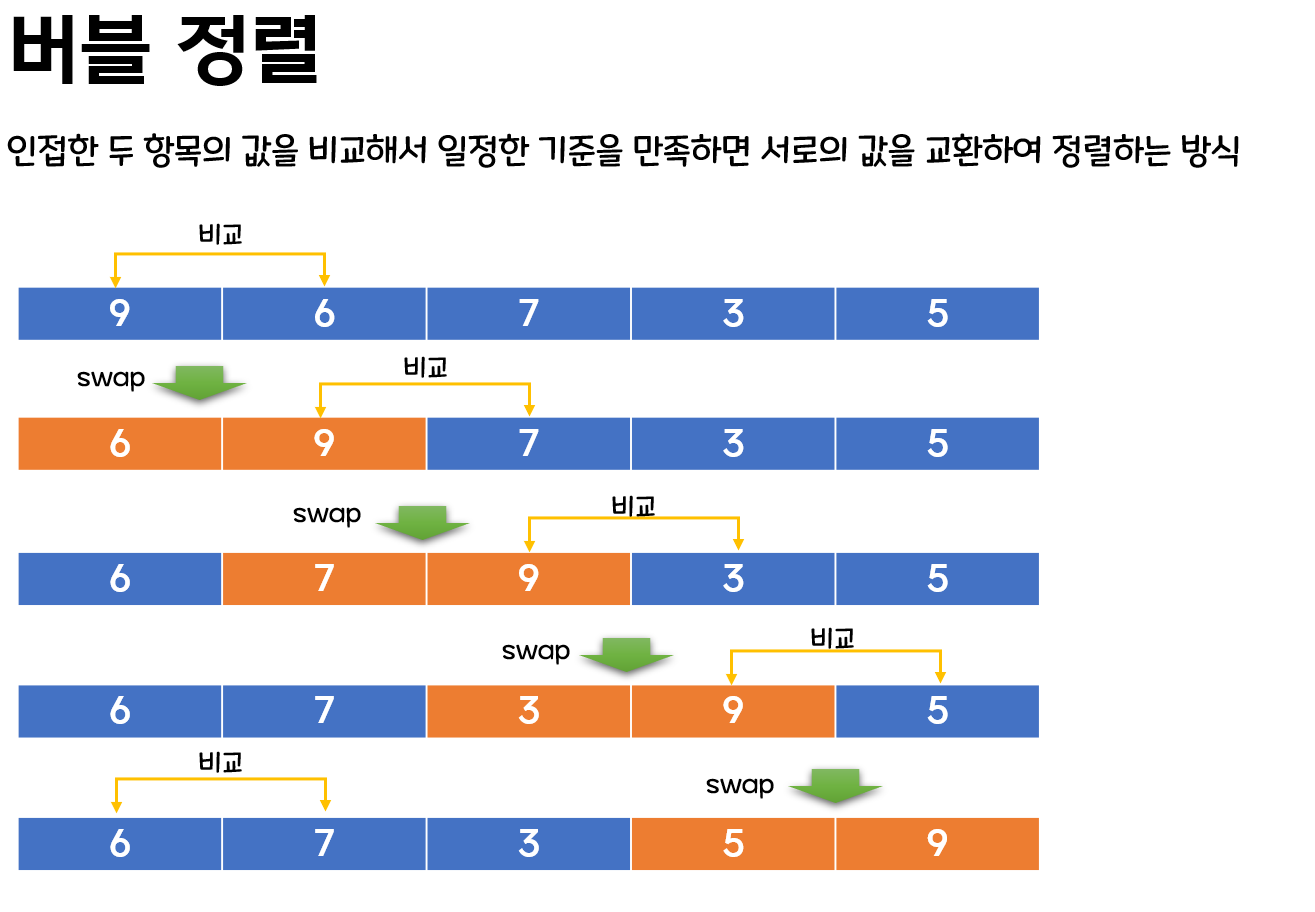
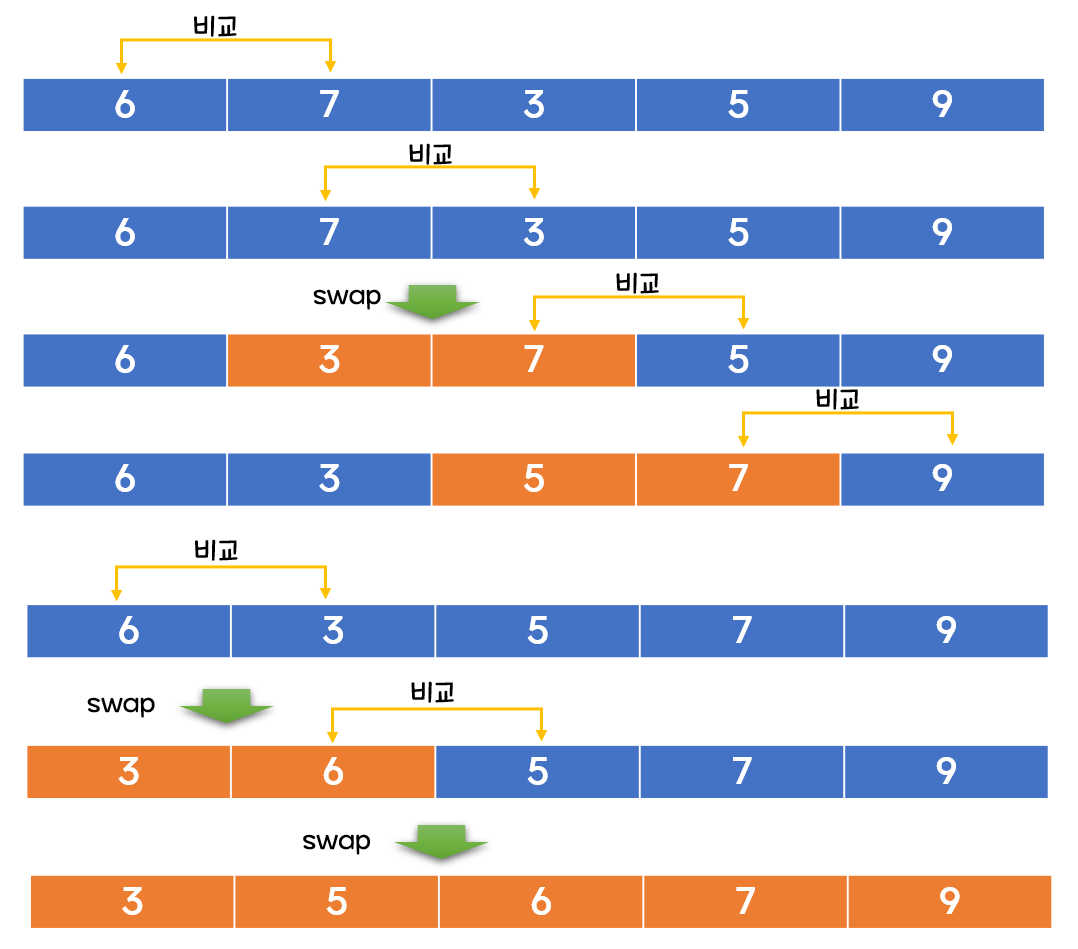
자바 코드
void bubbleSort(int[] arr) {
int temp = 0;
for(int i = 0; i < arr.length - 1; i++) {
for(int j= 1 ; j < arr.length-i; j++) {
if(arr[j]<arr[j-1]) {
temp = arr[j-1];
arr[j-1] = arr[j];
arr[j] = temp;
}
}
}
System.out.println(Arrays.toString(arr));
}
시간 복잡도
버블 정렬의 시간 복잡도는 이다 .
공간 복잡도
버블 정렬의 공간 복잡도는 이다.
6. 힙 정렬

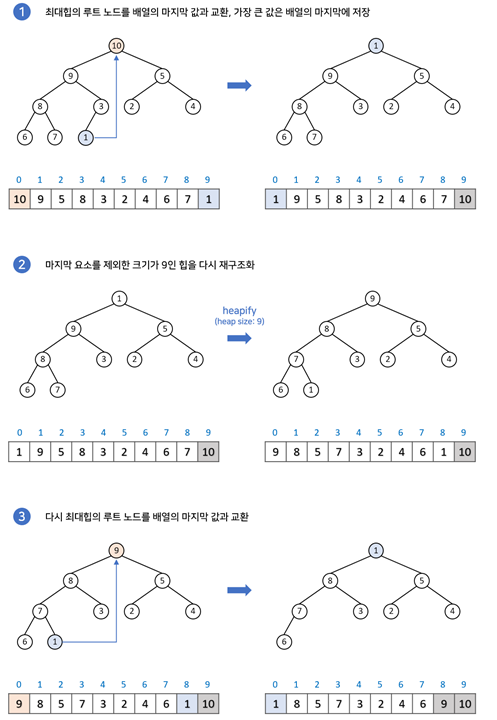
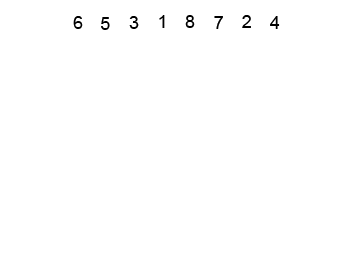
엄청 느리지만 힙 정렬되는 과정을 잘 보여준다. (출처)
자바 코드
public class Heap
{
private int[] element; //element[0] contains length
private static final int ROOTLOC = 1;
private static final int DEFAULT = 10;
public Heap(int size) {
if(size>DEFAULT) {element = new int[size+1]; element[0] = 0;}
else {element = new int[DEFAULT+1]; element[0] = 0;}
}
public void add(int newnum) {
if(element.length <= element[0] + 1) {
int[] elementTemp = new int[element[0]*2];
for(int x = 0; x < element[0]; x++) {
elementTemp[x] = element[x];
}
element = elementTemp;
}
element[++element[0]] = newnum;
upheap();
}
public int extractRoot() {
int extracted = element[1];
element[1] = element[element[0]--];
downheap();
return extracted;
}
public void upheap() {
int locmark = element[0];
while(locmark >= 1 && element[locmark/2] > element[locmark]) {
swap(locmark/2, locmark);
locmark /= 2;
}
}
public void downheap() {
int locmark = 1;
while(locmark * 2 <= element[0])
{
if(locmark * 2 + 1 <= element[0]) {
int small = smaller(locmark*2, locmark*2+1);
swap(locmark,small);
locmark = small;
}
else {
swap(locmark, locmark * 2);
locmark *= 2;
}
}
}
public void swap(int a, int b) {
int temp = element[a];
element[a] = element[b];
element[b] = temp;
}
public int smaller(int a, int b) {
return element[a] < element[b] ? a : b;
}
}시간 복잡도
힙 정렬의 시간 복잡도는 이다 .
공간 복잡도
힙 정렬의 공간 복잡도는 이다.
7. 합병 정렬
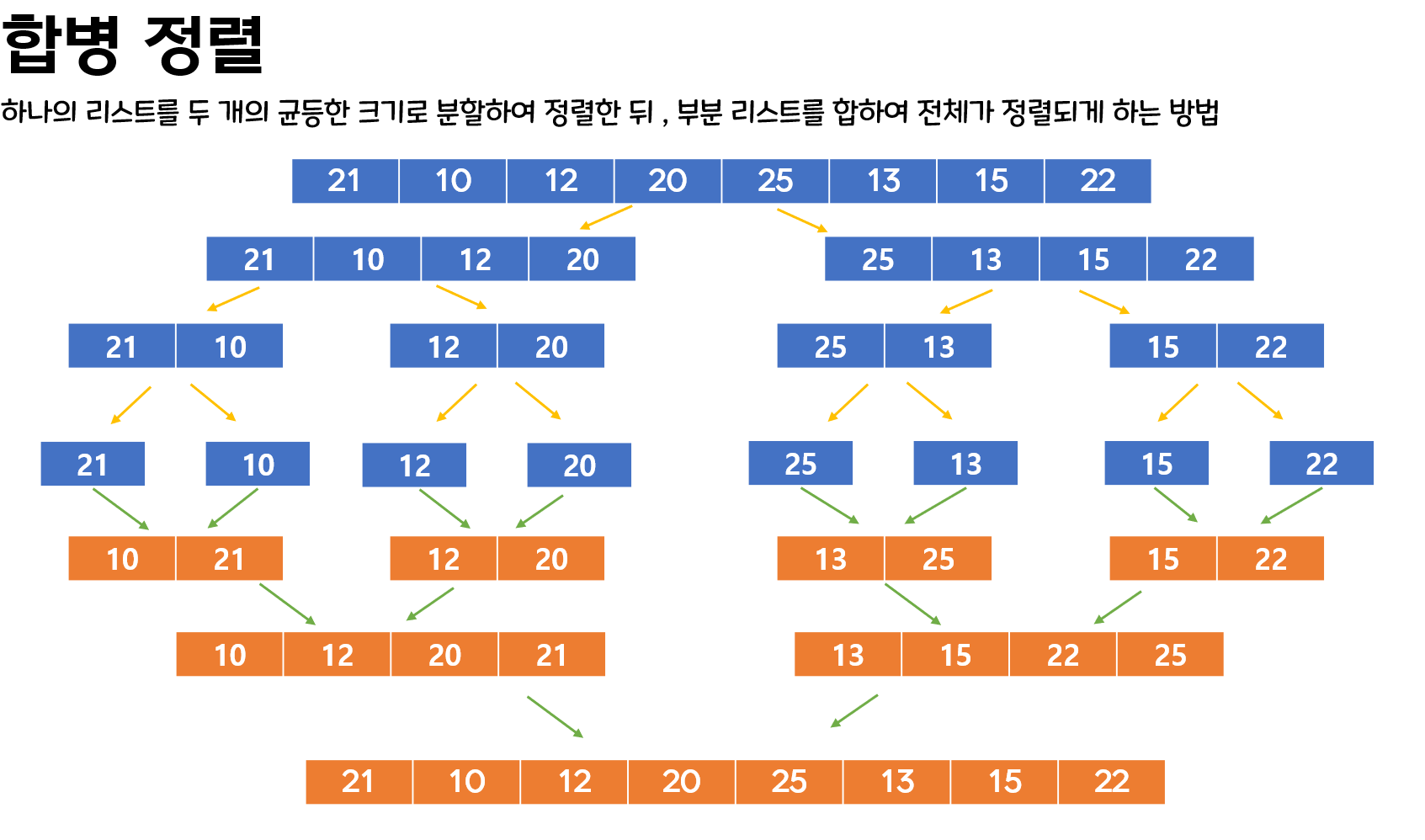
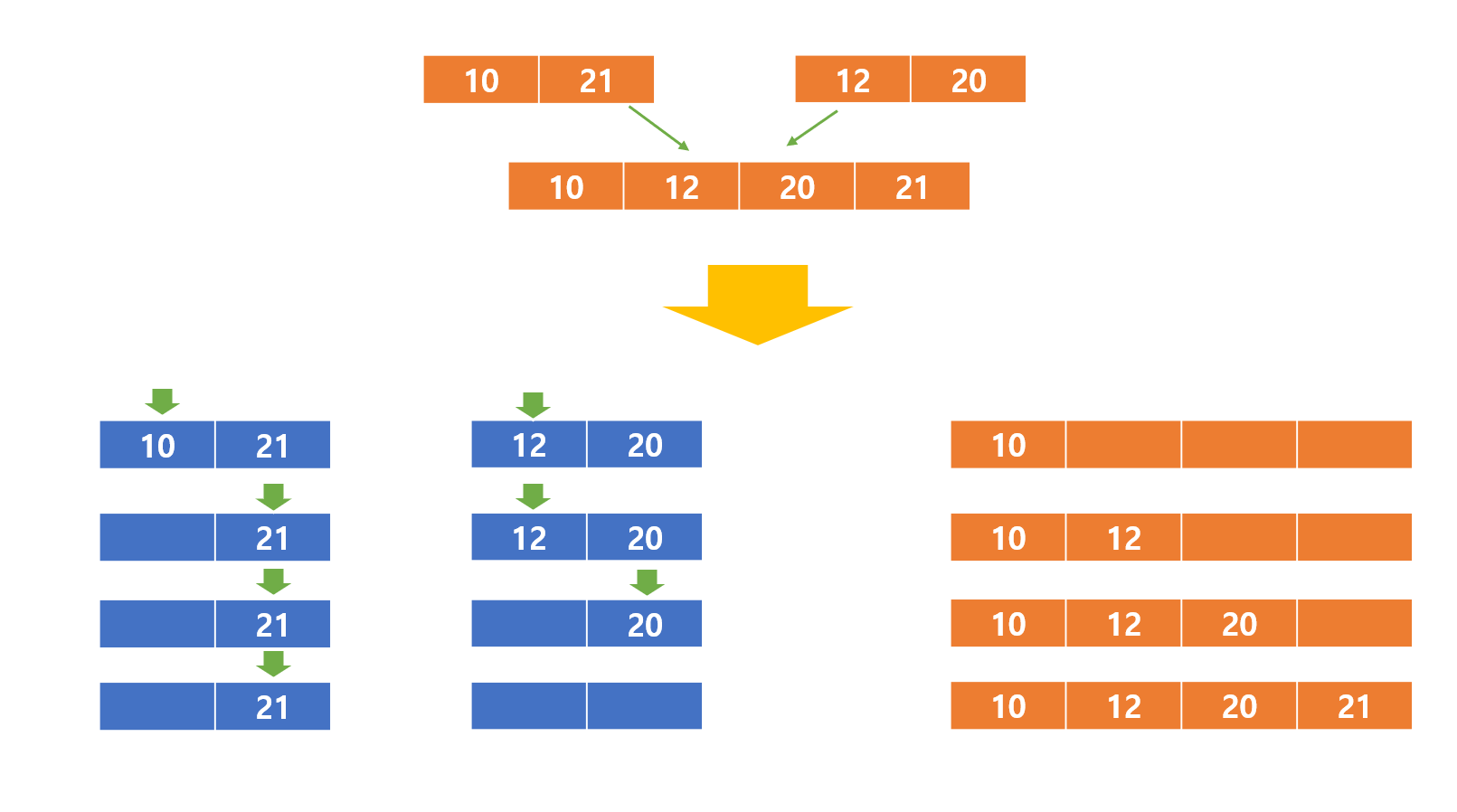
자바 코드
public class Main {
public static int[] src;
public static int[] tmp;
public static void main(String[] args) {
src = new int[] { 1, 9, 8, 5, 4, 2, 3, 7, 6 };
tmp = new int[src.length];
printArray(src);
mergeSort(0, src.length - 1);
printArray(src);
}
public static void mergeSort(int start, int end) {
if (start < end) {
int mid = (start + end) / 2;
mergeSort(start, mid);
mergeSort(mid + 1, end);
int p = start;
int q = mid + 1;
int idx = p;
while (p <= mid || q <= end) {
if (q > end || (p <= mid && src[p] < src[q])) {
tmp[idx++] = src[p++];
} else {
tmp[idx++] = src[q++];
}
}
for (int i = start; i <= end; i++) {
src[i] = tmp[i];
}
}
}
public static void printArray(int[] a) {
for (int i = 0; i < a.length; i++)
System.out.print(a[i] + " ");
System.out.println();
}
}
//출처 : https://yunmap.tistory.com/entry/%EC%95%8C%EA%B3%A0%EB%A6%AC%EC%A6%98-Java%EB%A1%9C-%EA%B5%AC%ED%98%84%ED%95%98%EB%8A%94-%EC%89%AC%EC%9A%B4-Merge-Sort-%EB%B3%91%ED%95%A9-%EC%A0%95%EB%A0%AC-%ED%95%A9%EB%B3%91-%EC%A0%95%EB%A0%AC시간 복잡도
합병 정렬의 시간 복잡도는 이다 .
공간 복잡도
합병 정렬의 공간 복잡도는 이다.
총 정리
| 정렬알고리즘 | 평균 시간 복잡도 | 공간 복잡도 | 특징 |
|---|---|---|---|
| 선택정렬 | 아이디어가 매우 간단하다. | ||
| 삽입 정렬 | 데이터가 거의 정렬되어 있을때 가장 빠르다 | ||
| 버블 정렬 | 구현이 매우 간단하다. | ||
| 퀵 정렬 | 대부분의 경우에 가장 적합하며, 충분히 빠르다 | ||
| 힙 정렬 | 최악의 경우에도를 갖는다 | ||
| 합병 정렬 | 최악의 경우에도를 갖는다 | ||
| 계수 정렬 | 한정적인 상황에 사용 가능하지만 매우 빠르다 |
출처 : https://herong.tistory.com/entry/%EA%B3%84%EC%88%98%EC%A0%95%EB%A0%ACCounting-Sort
